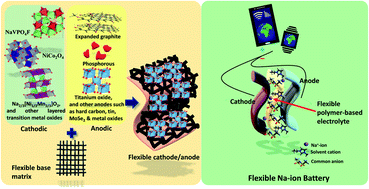Recent progress in electrode and electrolyte materials for flexible sodium-ion batteries
Abstract
Sodium ion batteries (NIBs) have gained remarkable attention as a potential alternative to lithium ion batteries for upcoming large-scale applications ranging from small electronic equipment to electric vehicles. In recent years, motivated by the growing market of flexible and wearable electronics, researchers have tried to build improved energy-storage systems with the capability of bending, folding and stretching. Significant progress has been made in the preparation of electrode and electrolyte materials for flexible NIBs. Flexible carbonaceous materials such as graphene oxide, carbon nanotubes etc., and other metals and their oxides/sulfides immobilized on flexible carbonaceous sheets have been explored as anodes for flexible NIBs. On the other hand, sodiated layer transition metal oxides, phosphates and few organic compounds pasted on flexible carbonaceous supports are proposed as potential cathodes. On the electrolyte part, polymer-based flexible films have shown their potential as promising systems. In this review article, recent progress and well-developed strategies for the preparation of electrodes and electrolytes to realize flexible and stretchable NIBs are discussed. The performance of promising flexible anodes and cathodes in terms of discharge capacities and cycling in Na half-cells is highlighted. Prospects for the further development of future flexible NIBs are also presented.



 Please wait while we load your content...
Please wait while we load your content...